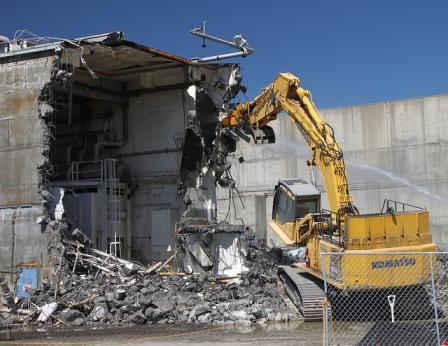Construction and Demolition Debris: Material-Specific Data
Construction and Demolition (C&D) debris is a type of waste that is not included in municipal solid waste (MSW). Materials included in the C&D debris generation estimates are steel, wood products, drywall and plaster, brick and clay tile, asphalt shingles, concrete, and asphalt concrete. These materials are used in buildings, roads and bridges, and other sectors.
On this page:
Overview
EPA measures the generation of C&D debris in the United States. The generation estimate represents C&D amounts from construction, renovation and demolition activities for buildings, roads and bridges.
 EPA estimated that 600 million tons of C&D debris were generated in the United States in 2018, which is more than twice the amount of generated MSW. For more information on methodology, see Construction and Demolition Debris Generation in the United States, 2015.
EPA estimated that 600 million tons of C&D debris were generated in the United States in 2018, which is more than twice the amount of generated MSW. For more information on methodology, see Construction and Demolition Debris Generation in the United States, 2015.
EPA also produced estimates for the 2018 mass quantities of C&D debris material intended for next use or sent to landfills. “Next use” designates an intended next-use market which, depending on the material, may include fuel, manufactured products, aggregate, compost and mulch or soil amendment. The manufactured products next use encompasses estimates of C&D debris processed (e.g. ground, crushed or extracted and melted) for incorporation in the manufacture of new materials and products. For example, C&D asphalt is processed for use in the production of asphalt mixtures. For more information on the 2018 data see Advancing Sustainable Materials Management: 2018 Fact Sheet. For more information on the methodology-see Construction and Demolition Debris Management in the United States, 2015.
Looking for more information on C&D debris? Check out these web pages:
- State Specific Information on C&D Materials
- Estimating 2003 Building-Related C&D Materials Amounts
- 1998 Characterization of Building-Related C&D Debris in the United States
Summary Table and Graph
The data below are from 1960 to 2018, relating to the total number of tons of construction and demolition debris generated. End destinations for construction and demolition debris have been added for 2015 and 2018.
| Management Pathway | 1960 | 1970 | 1980 | 1990 | 2000 | 2005 | 2010 | 2015 | 2017 | 2018 |
|---|---|---|---|---|---|---|---|---|---|---|
| Generation | - | - | - | 135,530 | - | 170,000 | - | 547,040 | 569,360 | 600,330 |
| Manufactured Products | - | - | - | - | - | - | - | 108,560 | - | 131,590 |
| Aggregate | - | - | - | - | - | - | - | 293,670 | - | 313,070 |
| Soil Amendment | - | - | - | - | - | - | - | 2,000 | - | 1,890 |
| Compost and Mulch | - | - | - | - | - | - | - | 2,610 | - | 2,460 |
| Fuel | - | - | - | - | - | - | - | 8,010 | - | 7,540 |
| Landfill | - | - | - | - | - | - | - | 132,190 | - | 143,780 |
Sources:
EPA, 1998. Characterization of Building-Related Construction and Demolition Debris in the United States that estimates the generation of building-related C&D materials in the U.S. in 1996.
EPA, 2009. Estimating 2003 Building-Related Construction and Demolition Materials Amounts that estimates the generation of building-related C&D materials in the United States.
EPA, 2018. Construction and Demolition Debris Generation in the United States, 2015.
EPA, 2019. Advancing Sustainable Materials Management: 2017 Fact Sheet.
EPA 2020a. Construction and Demolition Debris Management in the United States, 2015.
EPA, 2020b. Advancing Sustainable Materials Management: 2018 Fact Sheet.
A dash in the table means that data is not available.
A graph is not provided because sufficient data is not available in the table.
